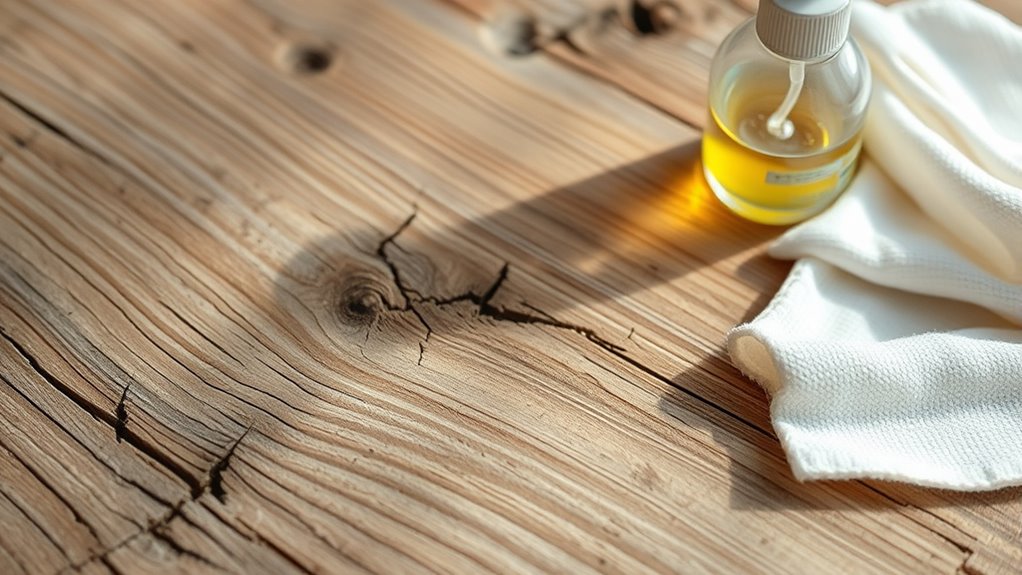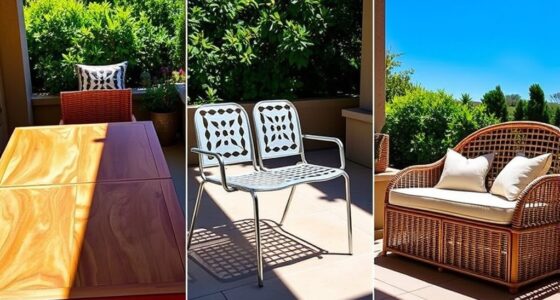To prevent and treat wood furniture drying out, you should maintain indoor humidity between 40-60%, using humidifiers or dehumidifiers as needed. Regularly dust with a soft cloth, and periodically apply a quality wood conditioner or oil to nourish the wood. Protect furniture from direct sunlight and heat. Using furniture polish helps lock in moisture and adds shine. For more tips on keeping your furniture in top shape, continue exploring these helpful strategies.
Key Takeaways
- Regularly apply high-quality furniture polish to lock in moisture and restore shine.
- Maintain indoor humidity levels between 40-60% using humidifiers or dehumidifiers as needed.
- Clean dust off surfaces frequently with a soft cloth to prevent surface damage and cracking.
- Use suitable wood conditioners or oils periodically to nourish and rehydrate the wood.
- Protect furniture from direct sunlight, heat, and sudden environmental changes to prevent drying and cracking.

Have you noticed your wood furniture looking dull or cracked? If so, it’s a sign that the wood isn’t getting the moisture it needs to stay healthy and vibrant. Over time, exposure to dry air, sunlight, and fluctuating temperatures can cause your furniture’s wood grain to shrink and crack. Luckily, you can prevent further damage and restore its natural beauty by taking simple steps to maintain proper moisture levels. One effective way is to regularly use a good quality furniture polish. Furniture polish not only enhances the shine but also creates a protective layer that helps lock in moisture, reducing the risk of drying out and cracking. When applying polish, focus on the wood grain, making sure to cover all surfaces evenly. This helps nourish the wood from within and keeps it looking fresh and lively.
Regular use of quality furniture polish helps lock in moisture and keeps wood furniture looking vibrant.
In addition to using furniture polish, controlling humidity levels in your home plays a critical role in preventing your wood furniture from drying out. Ideally, keep the indoor humidity between 40% and 60%. You can use a humidifier during dry winter months or in heated spaces to add moisture to the air. Conversely, during humid summers, a dehumidifier can help prevent excess moisture from seeping into the wood, which can cause swelling or warping. Proper humidity not only preserves the integrity of the wood grain but also makes it less prone to cracking and splitting. Furthermore, avoid placing furniture in direct sunlight or near heat sources like radiators or vents. Excessive heat and UV rays can accelerate drying and damage the finish, making the wood more brittle over time.
Another key step is regular cleaning and conditioning. Dust your furniture with a soft cloth to prevent abrasive particles from scratching the surface. Occasionally, apply a specialized wood conditioner or oil that penetrates the wood grain and replenishes lost moisture. Be cautious to choose products suitable for your furniture’s finish; some polishes and oils are better suited for certain types of wood or finishes. When applying any conditioning product, follow the manufacturer’s instructions carefully. This routine helps maintain elasticity in the wood fibers, reducing the chances of cracks developing as the wood dries out. Additionally, understanding the importance of wood properties can help you select the most appropriate products and methods for your furniture.
Finally, handle your furniture gently and avoid placing heavy or sharp objects on its surface, which can cause superficial damage and facilitate moisture loss. By combining these practices—using furniture polish, maintaining proper humidity, cleaning regularly, and conditioning—you’ll help prevent your wood furniture from drying out and preserve its beauty for years to come. Taking these small, consistent steps ensures your furniture remains a stunning and durable part of your home.
Frequently Asked Questions
How Can I Tell if My Furniture Is Too Dry?
You can tell if your furniture is too dry when wood expansion slows down or stops, and it feels brittle or rough to the touch. Dryness reduces moisture absorption, making the wood less flexible and more prone to cracks. Pay attention to cracks, warping, or splitting, which are signs your furniture isn’t retaining enough moisture. Regularly check for these signs to maintain proper moisture levels and keep your furniture healthy.
Are There Natural Remedies to Rehydrate Dried Wood?
Yes, you can use natural remedies to rehydrate dried wood. Mix a few drops of essential oils like lemon or lavender with a carrier oil such as olive or mineral oil, then gently apply it to your furniture. Afterward, buff the surface with beeswax polish to restore moisture and shine. This natural approach helps nourish the wood, preventing further drying and keeping your furniture looking beautiful.
How Often Should I Treat My Furniture to Prevent Drying?
You should treat your furniture with wood conditioning every 6 to 12 months to prevent drying. Regular application helps maintain moisture balance, especially if humidity levels fluctuate. Use a quality wood conditioner and make certain your room’s humidity stays between 40-60%. This routine keeps your furniture hydrated and prevents cracking or warping, making sure it stays beautiful and durable for years. Consistent care is key to preserving your wood’s natural integrity.
What Types of Finishes Are Best for Moisture Retention?
You should choose finishes like wood sealants or moisture barriers to best retain moisture. These finishes create a protective layer that prevents drying and cracking, especially in environments with fluctuating humidity. Apply a high-quality sealant regularly to maintain the moisture balance in your furniture. This proactive approach keeps your wood looking fresh, prevents dryness, and extends the lifespan of your furniture.
Can Drying Out Cause Permanent Damage to Wood Furniture?
Drying out your wood furniture can cause permanent damage, like making it crack or warp—it’s as if your furniture’s life is at stake! When wood loses moisture, it shrinks, leading to wood expansion and contraction, which results in cracks and splits. If you don’t maintain proper humidity, these issues become irreversible, permanently damaging your furniture’s appearance and structure. Keep it moisturized to prevent such costly, long-term damage.
Conclusion
By regularly maintaining your wood furniture with proper humidity levels and occasional conditioning, you can keep it looking beautiful for years. Don’t let it dry out and crack—after all, isn’t your furniture worth the extra care? With simple steps, you can prevent damage and guarantee your pieces stay vibrant and sturdy. So, why not take a moment today to protect your investment and enjoy the timeless beauty of well-maintained wood furniture?









